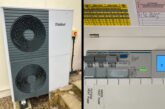
Essential technical advice from the team at ELECSA.
The RCD has become an indispensable protective device, selected to provide fault protection, additional protection and, in certain circumstances, protection against fire. RCDs are widely used and, therefore, it is necessary for electricians to have a sound understanding of this type of protective device. Table 1 shows a small sample of where RCDs are used.
Operation of an RCD
An RCD is defined in Part 2 of BS 7671 as being a mechanical switching device designed to open a set of contacts when the residual current (I∆n) reaches a given value. With reference to a single-phase RCD, the residual current refers to the difference between the current that is flowing in the line conductor compared to the current flowing in the neutral conductor under fault conditions. Under normal healthy conditions the current in the line conductor is equal to that in the neutral conductor; the main coils are configured in a manner that any magnetic field induced within the line coil is cancelled out by that induced by the neutral coil. No magnetic field is induced and the coil is balanced.
Under conditions where there is a difference in the current flowing in the line and neutral conductors, such as fault to earth conditions, an imbalance is created which causes a magnetic circuit to be set up in the core. This magnetic field is sensed by a search coil causing a current to flow. This current is amplified and fed to a relay which in turn operates the main contacts (Fig 1 refers). It must be understood that the current breaking ability of the main contacts is not related to the residual operating current value.
Selectivity between RCDs in series
On occasion, a domestic electrical installation may include RCDs connected in series, particularly where the installation forms part of a TT system. Where such RCDs provide fault protection or otherwise prevent danger, and where selectivity in their operation is necessary to prevent danger, Regulation 536.4.1.4 of BS 7671 requires that their characteristics are such that selectivity is achieved.
The need for selectivity is also implicit in Regulation 314.2. The regulation requires that a separate circuit be provided for each part of an installation that needs to be separately controlled for compliance with the Regulations or otherwise to prevent danger, so that such circuits remain energised in the event of failure of any other circuit of the installation, due account being taken of the consequences of the operation of any single protective device, such as a 30 mA RCCB at the origin protecting the whole installation.
Selectivity between RCDs connected in series is required for reasons other than to prevent danger. Regulation 314.1 requires that every installation be divided into circuits as necessary, not only to avoid danger but to minimise inconvenience in the event of a fault.
Where two or more RCDs are connected in series, selectivity will generally be achieved by selecting time-delayed characteristic(s) for the upstream device(s) and having a rated residual operating current of the upstream device of at least three times the rating of the downstream device (536.4.1.4).
Selectivity between RCDs can really only be accomplished by delaying the tripping of the RCD upstream such that the downstream RCD has time to disconnect the faulty circuit before the time delay of the upstream RCD has expired. It should be noted that RCDs used for additional protection are not permitted to have an operating time delay. Such RCDs must, as stated in Regulation 415.1.1, have a rated residual operating current not exceeding 30 mA.
Furthermore, where RCDs with a time delay (classified as type S) are used to provide fault protection, the total operating time is not to exceed the applicable maximum disconnection times required by Chapter 41 of BS 7671.
Testing RCDs
The purpose of the RCD test is to confirm that the device will operate within the disconnection time required by BS 7671. Where an RCD is used to provide fault protection, the test should be performed at any current equal to or greater than the rated residual operating current of the device. The disconnection time should comply with the general requirements detailed in Chapter 41.
Where an RCD is used to provide additional protection, the test should be performed at any current equal to or greater than 5 I∆n. The disconnection time should not exceed 40 ms (643.8).
Whilst product standard testing requires manufacturers’ to subject RCDs to tests at half their rated residual operating current (0.5 I∆n), a half-rated test is not required by BS 7671 to verify the effectiveness of an RCD, during initial verification or periodic testing.
For more information about ELECSA and membership options visit: www.elecsa.co.uk









